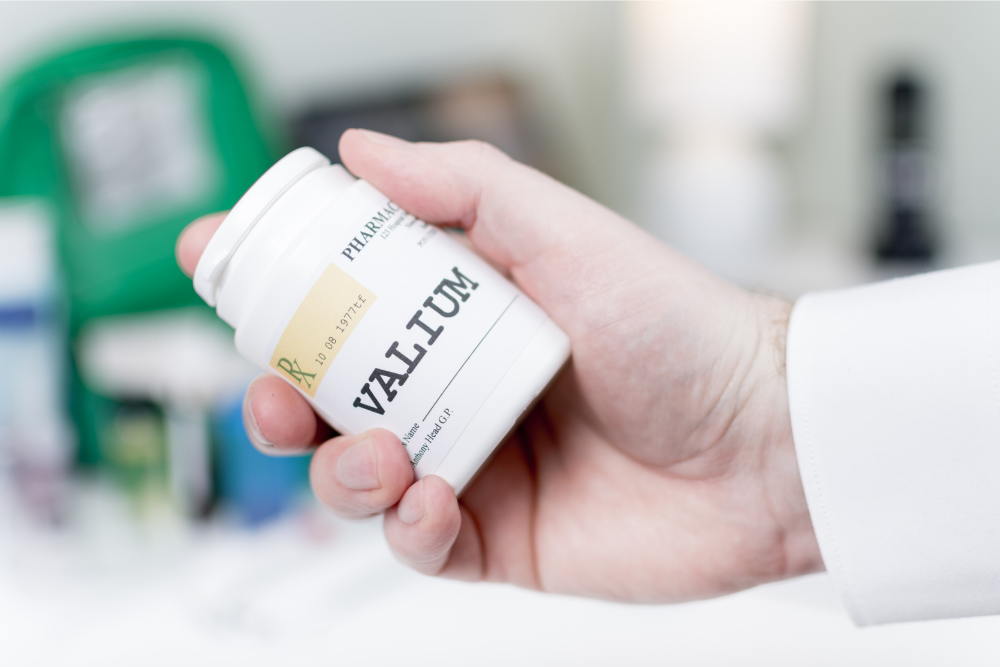Valium can be addictive. Using the drug for extended periods is not recommended as it can lead to dependence and tolerance, meaning you may need higher doses over time to get the same effect. Both dependence and tolerance can lead to addiction. Long-term Valium use can also cause side effects and health complications.
To minimize the risk of Valium addiction and dependence, doctors usually prescribe the drug for short-term use whenever possible. If longer-term treatment is needed, they will monitor the patient and consider other treatment options.
Key Takeaways on Valium Addiction
Valium (diazepam) is highly addictive, especially with long-term or improper use. Dependence builds quickly, and stopping suddenly can cause withdrawal.
- Valium dependence develops fast, often requiring higher doses of the drug to feel its effects.
- Valium addiction often leads to neglect of responsibilities, isolating tendencies, and risky behavior.
- Combining Valium with alcohol or other drugs greatly increases its danger.
- Always use Valium only as prescribed and seek help if you notice signs of addiction.
What is Valium?
Valium is the brand name for a medication whose generic name is diazepam, which is a class of drugs called benzodiazepines. It’s a long-acting benzodiazepine, meaning it stays in the body for a long time. Valium is FDA-approved for short-term treatment of conditions such as anxiety, muscle spasms, seizures, and alcohol withdrawal. Doctors prescribed over 3 million prescriptions for Valium in 2022.

Valium works by increasing the activity of a neurotransmitter called gamma-aminobutyric acid (GABA) in the brain. GABA reduces the activity of nerve cells in the brain. By increasing GABA activity, Valium is effective in managing anxiety because of its calming effect on the nervous system.
What Are the Side Effects of Valium?
Valium, also known by its generic name diazepam, can cause a range of side effects, including changes to a person's alertness, mood, and coordination. Some side effects are mild and temporary, while others can become serious with misuse or prolonged use.
Below are some of the most common side effects of Valium use:
- Drowsiness that may affect a person's ability to drive or operate machinery
- Dizziness or lightheadedness, especially when standing
- Muscle weakness, more noticeable at higher doses
- Trouble with coordination or balance
- Fatigue
- Dry mouth or, in some cases, excess saliva
- Changes in appetite
- Nausea or constipation
- Blurred or double vision
- Headaches
- Memory issues or trouble concentrating
More Adverse Effects of Valium Use
Some more serious effects of Valium use include:
- Allergic reactions like rash, swelling, or breathing difficulties
- Mood changes such as agitation, aggression, or hallucinations
- Risky or unusual behavior, including poor judgment
- Severe drowsiness or persistent weakness
- Difficulty breathing, especially when combined with other depressants

What Are the Signs and Symptoms of Valium Addiction?
Signs of Valium addiction show up when someone starts taking larger doses than they should, skips important things like work or school, or pulls away from the people around them. They might seem moody, secretive, or just not themselves.
Recognizing the signs of Valium addiction is important for early intervention and treatment. If someone has developed diazepam dependence or is abusing the drug, they may exhibit the following signs:
- Needing larger doses of Valium to feel the same effect.
- Feeling anxious, irritable, or having trouble sleeping when not using.
- Taking bigger or more frequent doses than they're supposed to.
- Spending a lot of time thinking about or trying to get Valium.
- Losing interest in hobbies or things they used to enjoy.
- Pulling away from friends and family.
- Forgetting or ignoring responsibilities at work, school, or home.
- Continuous Valium use, even when it causes problems.
- Seeing different doctors to get multiple prescriptions.
- Stealing money to buy Valium.
- Mixing Valium with alcohol or other drugs.
What Are the Effects of Valium Addiction?
Valium addiction leads to physical dependence, affecting both the body and mind, and causing mood changes as well as impaired daily functioning. To better understand these effects, it’s essential to understand how people can become physically dependent on diazepam.
How Does Diazepam Cause Physical Dependence?
Physical dependence on diazepam, the generic name for Valium, develops when the body and brain adapt to the drug’s presence, especially its effect on the central nervous system (CNS). Valium works by increasing the activity of gamma-aminobutyric acid (GABA), a neurotransmitter that calms nerve activity and relieves stress and anxiety. Over time, the CNS becomes used to this increased GABA activity, and the body needs higher doses of Valium to get the same effect. This escalation can quickly lead to valium drug abuse and a cycle of increasing dosage.

There’s a common misconception that prescription medications like Valium aren’t addictive. But when it’s misused or taken for too long, people can become addicted to Valium without even realizing it’s happening.
What Happens When Someone Stops Taking Valium?
When someone with physical dependence tries to reduce or stop taking Valium, withdrawal symptoms can occur. Symptoms of valium withdrawal can range from mild discomfort to severe symptoms like anxiety, muscle spasms, and even seizures. Because of these risks, anyone who is physically dependent should undergo a medically supervised detox.
What Are the Psychological Symptoms of Valium Use?
Psychological symptoms of Valium addiction often include anxiety, depression, mood swings, and difficulties with memory or concentration. These symptoms are related to the drug’s effect on the central nervous system (CNS), as Valium produces a sense of calm by increasing GABA activity. Over time, individuals may develop psychological dependence on Valium to manage stress, emotions, or daily challenges.
This psychological dependence makes it hard to stop using Valium even when negative consequences arise. Early intervention is key to address these symptoms and prevent further harm. Substance abuse treatment programs, including outpatient care, mental health services, and facilities like Avenues Recovery, are designed to help individuals understand the psychological symptoms of Valium addiction and develop healthier ways to cope.
What Happens When You Combine Valium with Other Drugs?
Combining Valium with opioids, alcohol, or other benzodiazepines can greatly increase the risk of serious side effects.
The DEA reports that benzodiazepine misuse, including drugs like Valium, is especially common among people who use heroin or cocaine. Opioid users also frequently mix benzos like Valium to boost euphoria — a dangerous combination that increases the risk of overdose and respiratory depression. Both opioids and benzodiazepines are CNS depressants, and together, their effects are more intense than when taken alone.
Mixing Valium with alcohol or other benzos like Xanax can also cause severe drowsiness, poor coordination, and higher chances of dependence or addiction.

How Much is Too Much Valium?
Taking too much Valium means going beyond the dose your doctor prescribed, which can be risky and harmful. Everyone’s body reacts differently, so what’s safe for one person might be too much for another. People who use the drug for a long time can develop tolerance of Valium, meaning they need higher doses to feel the same effect, and that’s a warning sign to be careful.
Mixing Valium with alcohol or other drugs increases the chances of serious problems like central nervous system depression and overdose. Symptoms of a valium overdose include extreme drowsiness, confusion, trouble breathing, and loss of coordination. If you ever feel like you need more than prescribed and you’re concerned about becoming addicted to Valium, talk to your doctor about using it safely and effectively.
What Is the Treatment for Valium Addiction?
Valium addiction treatment usually involves a combination of medical, psychological, and behavioral interventions. The first step is often a medical detox process for those with significant physical dependence on Valium. This involves gradually tapering the dosage under healthcare supervision to manage withdrawal symptoms. Detox should be done in a controlled setting, as suddenly stopping using the drug can cause anxiety, insomnia, tremors, and in severe cases, seizures.
After detox, patients may enter inpatient or outpatient treatment programs for ongoing support. Behavioral therapies like cognitive-behavioral therapy (CBT) help address triggers for valium addiction and change harmful behaviors.
If you’re struggling with Valium drug abuse, reach out to Avenues Recovery for top-notch, personalized treatment and support. The journey to lasting recovery starts now, you can do it!
FAQs About Valium Addiction
-
Is Valium a narcotic?
No, Valium (diazepam) is not a narcotic. Narcotics refer to a class of drugs called opioids and Valium is a different class of drugs called benzodiazepines. While both can cause sedation, Valium is used to treat anxiety, muscle spasms, and seizures. It works as a central nervous system depressant, slowing brain activity to produce calming effects. Opioids are used mainly for pain relief.
-
How long does it take to get addicted to Valium?
You can become addicted to Valium in as little as a few weeks, especially when taken in higher doses or more frequently than prescribed. Some people may start showing signs of Valium dependence within 2–4 weeks of regular use. The risk increases significantly if Valium is used without medical supervision or combined with other substances like alcohol or opioids.

-
What risk factors increase the likelihood of Valium addiction?
Certain factors can make Valium addiction more likely, especially with prolonged or unsupervised use. These include:
-
Personal or family history of addiction
-
Mental health conditions (e.g., anxiety, depression)
-
Using higher doses
-
Combining Valium with alcohol or other substances
-
Lack of medical supervision
-
High stress or past trauma



